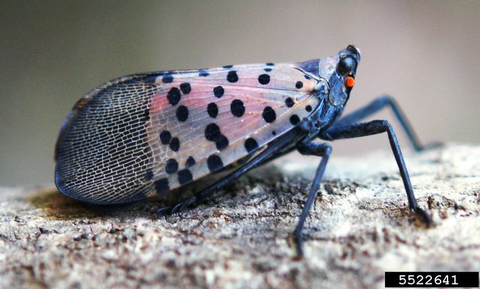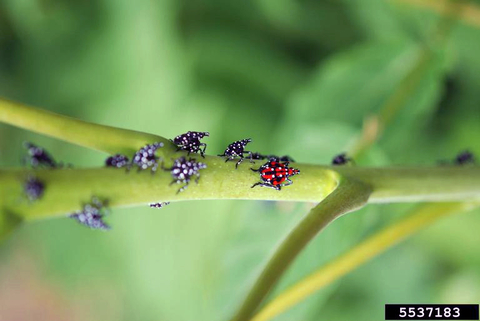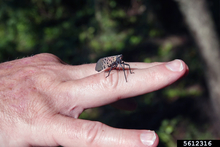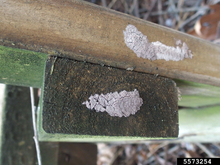In the last few weeks, the invasive insect spotted lanternfly has been reported in Michigan and Iowa. While we haven’t seen this insect in Minnesota, it is important that you know how to recognize this insect so that if and when it arrives in Minnesota, you can report it.
Early detection of invasive species can make a big difference in how successful early management efforts are, and this is an insect that could negatively affect Minnesota agriculture and gardeners.
What is spotted lanternfly?
Spotted lanternfly is an invasive insect that is native to China and was first found in Pennsylvania eight years ago. It has since spread to at least 12 states. It feeds on the sap of many trees that are common in Minnesota landscapes and can do economic damage to crops like grapes and apples.
- Adult spotted lanternflies are large (one to one and a half inches long).
- When at rest, they are taupe to gray with black polka dots on the wing.
- When in flight, you can see their lower wings, which are a combination of black, white and red.
- Before they are adults, nymphs do not fly, but the spotted theme continues.
- Larvae are black with white spots, and as they approach adulthood, are red with spots.
Why care about spotted lanternfly?
This pest has the potential to damage Minnesota crops and landscape trees, and become a public nuisance. It is estimated that in Pennsylvania, where this pest was first found, the insect costs the state over $300 million dollars annually.
Beyond the economics, these insects are large, highly mobile, and can have large populations. If you thought box elder bugs were big and annoying, wait until you meet spotted lanternfly. People who live in infested areas on the east coast complain about not only their high populations ("it is raining spotted lanternfly"), but also the sticky residue they leave behind after feeding.
What do spotted lanternflies like to eat?
Spotted lanternfly’s preferred host is tree-of-heaven. This is an invasive, weedy tree that is on the Minnesota noxious weed list, and is most likely to be found in southeastern Minnesota. Spotted lanternfly feeds and reproduces successfully on tree-of-heaven.
Spotted lanternfly also feed on over 100 species of woody plants. This includes apples, plums, grapes, and many common landscape trees likes pines, willows, and maples.
How does spotted lanternfly get around?
Despite being a large, showy insect, spotted lanternflies can be quite sneaky. This is due to the appearance of its eggs. Spotted lanternfly lays a group of many eggs at one time, and isn’t too picky about where these eggs go. They can be laid on rocks, trees, wood, lawn furniture, and in wheel wells.
The appearance of these eggs isn’t flashy, if you were just walking by you might just think that the egg mass was a splat of mud. As people unknowingly move items with eggs on them, they introduce spotted lanternfly to new areas.
The adult insect themselves can also hitchhike a ride on the same materials that egg masses can be found on.
What should I do to stop spotted lanternfly?
One big step is to inspect your vehicle if travel takes you to an area with a spotted lanternfly infestation. Again, eggs are subtle and easy to move by accident, so give your car, trailer, or camper a thorough once-over when you get back to Minnesota. If you find eggs or adults, scrape them off and smash them.
If you think you’ve seen a spotted lanternfly, don’t be shy about reporting it! Even if you aren’t 100% sure, it's okay. It is better to report and be wrong than to not report at all. Again, knowing where this insect is early is important to keeping it out of Minnesota.
What should I do if I think I’ve seen a spotted lanternfly?
The Minnesota State Department of Agriculture keeps track of where invasive species have been spotted. If you suspect that you’ve seen a spotted lanternfly, report it to the state via email at Arrest.the.Pest@state.mn.us or by phone at 1-888-545-6684, or use the MDA’s online form.






